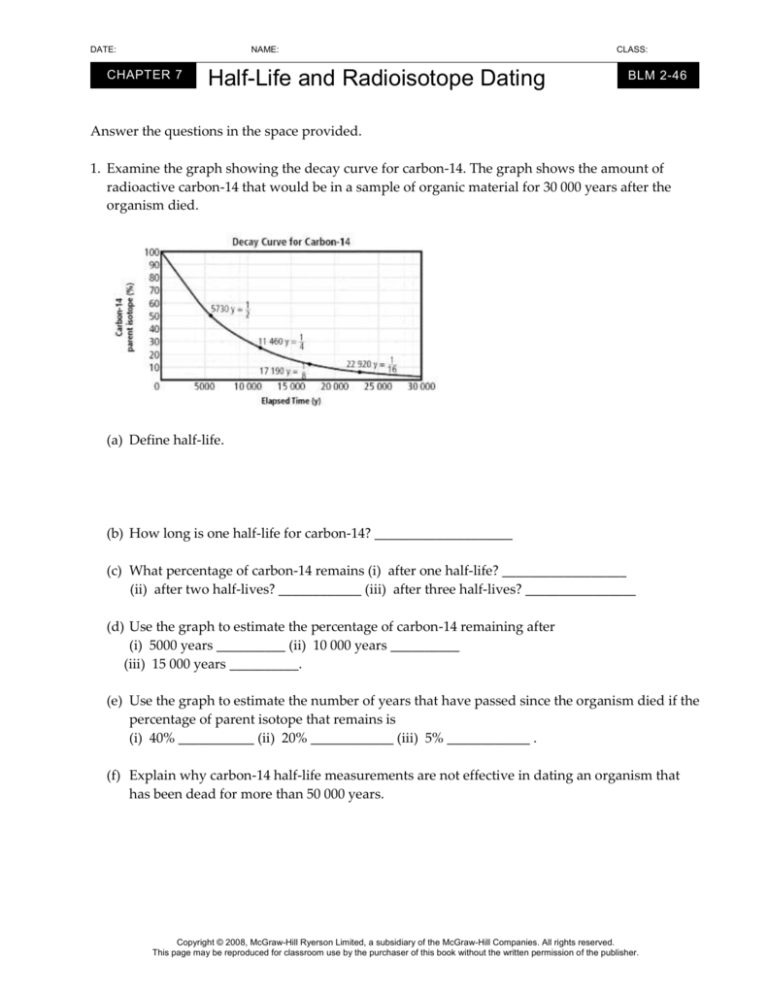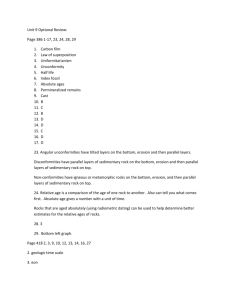
DATE:
NAME:
CHAPTER 7
Half-Life and Radioisotope Dating
CLASS:
BLM 2-46
Answer the questions in the space provided.
1. Examine the graph showing the decay curve for carbon-14. The graph shows the amount of
radioactive carbon-14 that would be in a sample of organic material for 30 000 years after the
organism died.
(a) Define half-life.
(b) How long is one half-life for carbon-14? ____________________
(c) What percentage of carbon-14 remains (i) after one half-life? __________________
(ii) after two half-lives? ____________ (iii) after three half-lives? ________________
(d) Use the graph to estimate the percentage of carbon-14 remaining after
(i) 5000 years __________ (ii) 10 000 years __________
(iii) 15 000 years __________.
(e) Use the graph to estimate the number of years that have passed since the organism died if the
percentage of parent isotope that remains is
(i) 40% ___________ (ii) 20% ____________ (iii) 5% ____________ .
(f) Explain why carbon-14 half-life measurements are not effective in dating an organism that
has been dead for more than 50 000 years.
Copyright © 2008, McGraw-Hill Ryerson Limited, a subsidiary of the McGraw-Hill Companies. All rights reserved.
This page may be reproduced for classroom use by the purchaser of this book without the written permission of the publisher.
DATE:
NAME:
CLASS:
BLM 2-46
continued
2. Volcanic rocks can be dated using the potassium-40 clock, a dating method based on the decay
of the potassium-40 isotope into the argon-40 isotope. Potassium-40 can exist as hot molten rock,
whereas argon-40, the daughter isotope, escapes from the molten rock because it is a gas. When
the molten rock solidifies, potassium-40 is present, but argon-40 is absent. The age of volcanic
rock can be measured by comparing the amount of these two isotopes present in the rock.
(a) Why is there no argon-40 present in the molten rock when it solidifies?
(b) After many years, argon-40 is present in volcanic rock containing potassium-40, even though
no argon-40 was there to begin with. How did the argon-40 get there?
(c) What is the length, in years, of one half-life of potassium-40? __________________
(d) Suppose a sample of volcanic rock contained 100 nanograms (a nanogram is a billionth of a
gram) of potassium-40 when the rock first formed. How many nanograms of potassium-40
and of argon-40 would be present in the sample after
(i) 1 half-life? ________________
(ii) 2 half-lives? ________________
(iii) 3 half-lives? ________________
Copyright © 2008, McGraw-Hill Ryerson Limited, a subsidiary of the McGraw-Hill Companies. All rights reserved.
This page may be reproduced for classroom use by the purchaser of this book without the written permission of the publisher.
DATE:
NAME:
CLASS:
BLM 2-46
continued
3. The table of parent-daughter isotopes shows three different isotope pairs that are used in
radioisotope dating. Examine the chart and answer the following questions.
(a) Lead-207 is called the daughter of uranium-235. What does this mean?
(b) How old is a rock sample that contains uranium-235 and lead-207 in equal amounts?
_________________________
(c) The age of Earth was first established in 1953 when Claire C. Patterson of the California
Institute of Technology used a uranium-lead clock to analyze rock. In comparing amounts of
uranium-235 with lead-207, he established that slightly less than 8 half-lives of uranium-207
had passed since the rock formed. Using this data, estimate the age of Earth.
_________________________
Copyright © 2008, McGraw-Hill Ryerson Limited, a Subsidiary of the McGraw-Hill Companies. All rights reserved.
This page may be reproduced for classroom use by the purchaser of this book without the written permission of the publisher.








